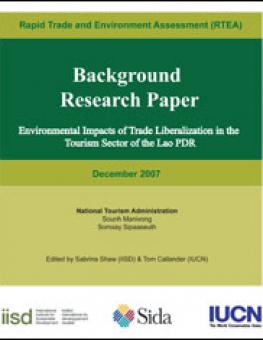
Environmental Impacts of Trade Liberalization in the Tourism Sector of the Lao PDR
The development of the tourism industry in Lao PDR over the last two decades has been striking. In 1990, just over 14,000 people visited the country. In 2006, arrival numbers stood at 1.21 million and generated 173.2 million dollars for the Lao PDR economy. This paper seeks to identify some of the key impacts, both positive and negative, of this sector and outline strategic policy recommendations to ensure this increase in business for Lao PDR results in a sustainable industry that enhances the surrounding environment.
Key findings:
-
The tourism sector in Lao PDR is growing as a result of better regional integration through ASEAN, increased relationships with countries beyond Asia such as the U.S., Europe and Australia, and successful national tourism promotion policies and projects.
-
Tourism is a key sector that meets all the Government of Lao PDR's key development objectives by generating a substantial amount of foreign currency each year. It is: labour-intensive, thus providing jobs; is inherently pro-poor, as earnings are made by many small businesses including poor villages in and around key attractions; and above all it works in harmony with nature.
-
If done well, tourism can have many positive effects on Lao PDR's natural environment, but without careful planning and a strong commitment from all stakeholders, negative impacts affecting the very asset on which the industry relies can arise.
-
Key to sustainable tourism is recognizing the "carrying capacity of an area"—the threshold level of tourist activity beyond which damage to the environment will occur.
Key recommendations:
-
continue to engage closely with the regional and international community to facilitate and promote the regional adoption of policies, practices and approaches to ecotourism;
-
strengthen the Lao National Tourism Authority's ability to engage with the private sector and investment decision-makers to encourage best-practice ecotourism and tourism development;
-
explore the potential of certification for the tourism industry in Lao PDR, both at the national and provincial levels;
-
strengthen central/provincial cooperation in the tourism sector; and
-
continue to support conservation with particular emphasis on National Protected Areas and linking with regional initiatives that promote tourism and conservation in the Greater Mekong Subregion and ASEAN.
Additional downloads
You might also be interested in
Will the Inclusion of Voluntary Standards in Trade Agreements Lead to More Sustainable Trade?
The use of voluntary sustainability standards (VSSs) and similar systems in free trade agreements (FTAs) is gaining traction. Will it lead to more sustainable production and consumption globally?
Strategic Environmental Assessment for the Mining Sector
Strategic environmental assessments (SEA) are an essential tool for policy-makers working to develop a sector-wide vision for responsible mining.
Blackouts and Backsliding: Energy subsidies in South Africa 2023
Blackouts and Backsliding presents the latest energy subsidy data for South Africa.
Sustainable Asset Valuation of Parques del Río Norte in Medellín, Colombia
This economic valuation demonstrates the benefits of expanding urban green space in the city of Medellín, Colombia.